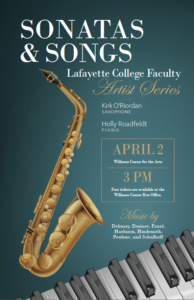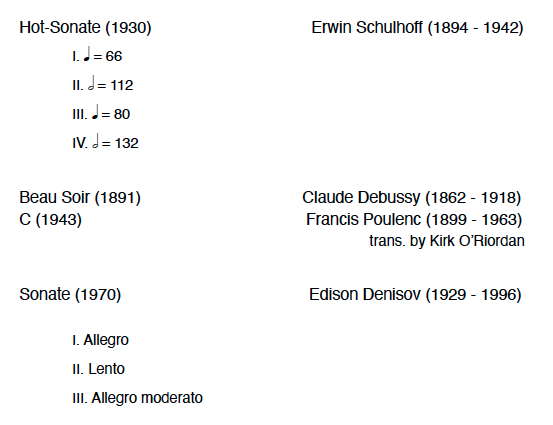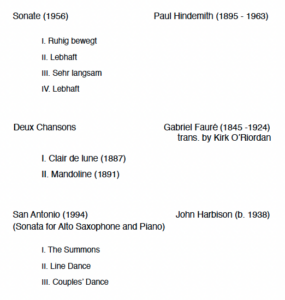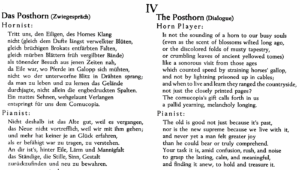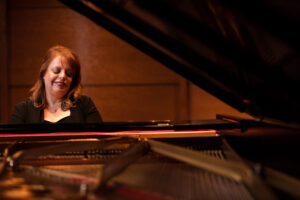Kirk O’Riordan, saxophone
Holly Roadfeldt, piano
Sunday, April 2, 2023
Williams Center for the Arts
Lafayette College
3:00 pm
Program
Intermission
Notes on the Program
Thank you for sharing your afternoon with us and supporting The Department of Music at Lafayette College. Holly and I are thrilled to share these pieces with you.
Today’s program features a nice variety of styles, from late 19th-century French Romanticism to jazz to avant-garde. Despite the stylistic variety, all of these pieces have one thing in common: they are composed with an equal partnership between the players in mind. The term “sonata” derives from the Italian sonare, or “to sound,” and was originally defined as music for instruments (as opposed to “cantata,” which was for voices). Over time, the number of instruments used in a sonata fluctuated from one to four, but the modern understanding of the term implies a multi-movement work for one (usually piano) or two instruments (one of which is usually piano). Composers conceived of both parts as being of equal importance: some composers, like Beethoven and Brahms, stressed the importance of the piano part by listing it first (Beethoven’s Sonatas for Piano and Violin, for example).
Art Song in the Romantic Period was a three-part ensemble: the pianist, the singer, and the text. Composers worked hard to illustrate the poetry in their settings–some, like Schubert, took pains to reproduce images from the text in recognizable musical gestures; others, like the three composers you will hear today, sought to amplify the more intangible aspects of the poetry–mood, for example–in their settings.
All of these pieces on our program demonstrate their composer’s intention to create two-person orchestras. Neither individual part is complete without its partner.
Schulhoff: Hot-Sonate
Erwin Schulhoff was just eight years old when he first caught the attention of famed composer Antonin Dvořák, who, after hearing Schulhoff play and improvise at the piano advised the young prodigy to begin composition study immediately. He later studied with Max Reger and Claude Debussy, and became close friends with fellow composer Alban Berg, painter Paul Klee, and other artistic luminaries of the WWI era.
His skills as an improvisor led him to a love of jazz, and this love is readily apparent in the Hot-Sonate. The work was composed on a commission from the Funk-Stunde AG Radio Station in Berlin in 1930. The premiere was given there with saxophonist Billy Barton and Schulhoff performing. The four movements are rife with syncopations, polymeter, and abrupt endings. The third movement asks the saxophonist to bend and slide into phrases while the piano maintains an even tempo. The finale begins with a driving opening theme before diverting into a lyrical recapitulation of some of the sonata’s previous melodic ideas.
A Jew with Soviet sympathies, Schulhoff was granted Soviet citizenship in 1939 to protect him from arrest after Germany’s 1939 invasion of Czechoslovakia, but with the Nazi invasion of Russia in 1941 he was arrested and later sent to the Wulzberg Concentration Camp where he died on August 18, 1942.
Beau Soir (Claude Debussy)
C. (Francis Poulenc)
Debussy’s “Beau Soir” (Beautiful Evening) sets a poem by Paul Bourget that describes an evening where water turns rose-red by the setting sun and wheat in the fields is is made to sway by a gentle breeze. Throughout, there is a sense of peace that is briefly interrupted at the song’s climax. In typical Debussy fashion, the harmonies are colored with whole-tone scales, melodic tritones, and 3-against-2 rhythms.
Poet Louis Aragon was a founder of the Surrealist movement and an ardent Communist, and as such was earnestly pursued by the Gestapo during the German occupation of France during the Second World War. Indeed, Aragon became a member of the Resistance, specializing in organizing and coordinating acts of intellectual and artistic rebellion against the Nazi occupation. This text describes a place where a bridge crosses the Loire–abbreviated “C.”– and concludes with the line: “O my France, my forsaken France. I have crossed the bridges of C.”
Poulenc set two of Argon’s resistance poems, though “C.” has become one of the most performed songs in his catalog. Poulenc wrote of the difficulties of creating legato sounds in the song, He writes specifically of the quarter-note chords in the piano part and the subtleties of pedaling them, noting that they “should be veiled.”
Denisov: Sonate for Alto Saxophone and Piano
Born in Siberia, Edison Denisov attended the Moscow Conservatory where he studied with Shostakovich. He soon developed a deep interest in t modern, and decidedly non-Russian scores by the likes of Mahler, Debussy, Boulez, and Stockhausen, which caused his Russian contemporaries to criticize him for being too Western. A man of many contradictions: Denisov was a mathematician before becoming a composer; he once said that the most important element of his music is lyricism while embracing serialist techniques; yet these paradoxes manifest in this sonata in a way that seems natural and organic.
The first movement is strictly serial in its construction, alternating between very rhythmic pulses and free, almost improvisatory virtuosic passages. Its primary theme can be recognized by its distinctive chromatic fragment first heard in the opening bar. The second movement is for saxophone alone (with a few gestures from the piano toward the end of the movement). This movement perhaps best displays both the lyricism and the modernist aesthetics of Denisov’s sound world: multiphonics, quarter-tones, and other delicate effects are used with great efficiency. The final movement begins immediately after the middle movement: in this movement one will bear a pronounced Be-Bop influence, with the opening walking bass line giving way to what could easily have been a free-form improvised solo played by John Coltrane.
This piece has become a staple in the saxophone/piano repertoire. Its technical challenges and aesthetic charisma make this piece a joy to perform, and despite its modernist tendencies it is a favorite on non-saxophonist audiences as well.
Hindemith: Sonate
Paul Hindemith’s compositional lineage, like that of many of his modern Germanic counterparts, can be traced back to the contrapuntal styles of J.S. Bach. As a child he entered Dr. Hoch’s Konservatorium where he studied violin; in his early professional musicianship he performed extensively with several string quartets as well as the Frankfurt Opera Orchestra, where he became Concert Master in 1916.
Hindemith’s compositions are often described as neoclassical in style, owing to carefully designed formal architectures and complex contrapuntal textures. Known for having written music for virtually every available instrument, Hindemith’s sonatas for brass instruments–notably trumpet, trombone, and tuba–have become some of his most performed works.
Among these is the Sonata for Alto Horn and Piano of 1956. The alto horn is slightly smaller than the modern Euphonium with a pitch range that closely matches that of the Alto Saxophone. When Hindemith discovered that the alto horn was not commonly used in the United States, he authorized the use of the saxophone as a substitute. No alterations to the piece were necessary to make this change, but he did include the following poem for the saxophone version, which is to be read before the final movement:
Fauré: “Clair de lune” and “Mandoline”
These two pieces share a poet, Paul Verlaine, who was perhaps best known as one of the founding members of the Symbolist movement in poetry. Like his colleague Stéphane Mallarmé, his poems were highly influential to other artists: painters like Monet and composers like both Fauré and Debussy.
“Clair de lune” (Moonlight) is one poem that has had a particularly strong influence on Fauré’s composer contemporaries: this is also the poem that inspired Debussy’s well known work of the same title. The setting demonstrates aspects of Symbolist poetry, particularly in its approach to meter: while notated in three, the opening gesture shrouds the meter in metaphor and makes the cadence in bar 8 feel like it is the beginning of a new phrase, not the end of the old phrase. Odd metrical groupings abound in the setting, with units of twos and threes, feeling displaced from the bar lines on the page.
“Mandoline” was composed in Venice in May of 1891. Like “Clair de lune,” its text was first published in Verlaine’s 1869 collection, Fêtes galantes. Incidentally, this text was also set by Debussy.
While Fauré typically stayed away from directly illustrating the text with musical gestures, the opening piano gesture seems to be vaguely reminiscent of the strumming of a mandolin.
Harbison: San Antonio (Sonata for Alto Saxophone and Piano)
John Harbison won the 1987 Pulitzer Prize for Music for his cantata: The Flight Into Egypt. His music is infused with vernacular styles and reflects a driving interest in discovery and experimentation. His credo has been to “make each piece different from the others, to find clear, fresh, large designs, to reinvent traditions.”
San Antonio was commissioned by the World-Wide Concurrent Premieres and Commissioning Fund. The work was first performed on December 3, 1995 by almost 80 saxophone/piano duos concurrently in different venues. The sonata describes the memories of a traveler after having found himself in the midst of a fiesta on a hot afternoon in San Antonio. The following are Harbison’s notes:
I. The traveler has a free afternoon in San Antonio. It is August, 105 degrees. Expecting to start with the cool promenade along the river, he is instead lured by a sound. He follows it up a long stairway and finds himself in a little fiesta: a hot square, many people, no shade, a few people dancing to a fast beat, the band playing and singing in Spanish.
II. The first dancers finish, exhausted. Then, as if on cue, the whole crowd gets into a line of people of all ages, nine to ninety. They all know the steps, which change with the phrases.
III. The music changes again becoming slower. The people continue on in couples. No one seems to feel the heat and the band hardly stops. Everyone, the traveler included, sinks into it. Towards the end, a young girl asks the traveler to dance. He declines But a year later, when the tourist puts down the memory of the sounds, something about a saxophone, and a few rhythms in his distorted memory, he accepts.
Artist Biographies
Holly Roadfeldt, piano
Few musicians balance the new opposite the old quite like American pianist Holly Roadfeldt. Recently deemed a “perfect pairing of technical prowess and innate sensitivity” (American Record Guide), Roadfeldt has established herself as one of contemporary music’s most prolific ambassadors—to date, she has made over 150 world premieres by more than four dozen composers. Recognized by audiences and critics for both her technical facility and distinctive interpretation of music from all eras, Roadfeldt has appeared on stages and venues across Canada, Europe, Asia, and over 30 U.S. states.
Roadfeldt tirelessly searches for like-minded composers who share her obsession with creating opportunities for listeners to relate to the music they hear. Best demonstrating this ethos is her three-year artistic flagship, “The Preludes Project,” which saw Holly premiere 65 new preludes by 16 composers. In touring the concept across 17 states, her lecture-recitals connected the present and the past, pairing the newly composed preludes with curated works within the standard repertoire. The concept drew rave reviews and attention across the industry, leading to Holly’s debut album, a collaboration with multi-GRAMMY® award winning producer Andreas Meyer. The Preludes Project CD (2016) released on PARMA Recordings, pairing Chopin’s Op. 28 Preludes with composer Kirk O’Riordan’s Twenty-Six Preludes for Solo Piano (2014). The album complements her numerous PARMA album collaborations with composers, including Mara Gibson’s Sky-Born (2017), and two other albums with O’Riordan: Strange Flowers (2013) and the recent release of Autumn Winds (2020), her second collaboration with Andreas Meyer.
Music critics across the United States, Canada, Italy, U.K., and Spain have taken notice, including American Record Guide, whose Autumn Winds review simply remarked that “Holly Roadfeldt is on fire.” Gramophone’s Donald Rosenberg praised her as “a vivid pianist” with “beautiful playing”, while for The Preludes Project CD, she received accolades from World Music Report for an “utterly convincing, breathtaking sense of elation” with “a varied touch that perfectly matches the mood of each piece.” Sonograma deemed the album worthy of “all of our highest praise,” joining other colorful superlatives like “jaw-dropping” (Mainly Piano) and “exquisite” (Cinemusical).
Known for premiering an eclectic array of exciting music, much of Roadfeldt’s recent pedagogical and artistic philosophy can be credited to Lisa, a 13-year old student who wondered why she “was only studying music written by men.” Driven to make that lesson the last time she heard that question, Holly has since prioritized including composers across the gender spectrum in her pedagogy. As a performer, composers she has commissioned span a number of the field’s most innovative voices, including Rasa Daukus, Mara Gibson, Michelle McQuade Dewhirst, Kala Pierson, Jessica Rudman, Julia Seeholzer, Stephanie Ann Boyd, and many others. With Lisa in mind, Roadfeldt hopes to encourage young female students to walk fearlessly down the road of self-expression and creativity.
Now a veteran of collaborating during the composition process, Holly pays her experience forward in masterclasses across the United States, teaching effective piano writing to university level composers. Her recurring lecture series “Classical Café” and “Classical Conversations” intersects Roadfeldt’s equal comfort with both performing and relating music to audiences. Taking place since 2017, each event explores themes like darkness, virtuosity, and even Bob Dylan, showing their direct influence on iconic repertoire throughout history using live musical examples.
Holly has taken the stage in myriad contexts and remains in high demand as a performer. Among her fondest memories are her performances of Chopin’s complete catalog of Preludes with revered Montréal-based dance troupe Compagnie Marie Chouinard. As a chamber musician, Holly has performed with members of the Metropolitan Opera Orchestra, the New York Philharmonic, the Chicago Symphony Orchestra, the Montreal Symphony, the Orchestre Philharmonique de Strasbourg, the Frankfurt Opera, the Finnish Radio Symphony Orchestra, and the Brussels Philharmonic as well as with concert artists Alexa Still, Bonita Boyd, and Marcia Baldwin.
Holly’s first professional performance came at 13 years old, performing with the Toledo Symphony Orchestra. Her fire in pursuing contemporary music ignited at the Eastman School of Music, where she was first able to collaborate with composers—Roadfeldt would go on to win First Prize in the Frinna Awerbuch International Piano Competition in its Contemporary Music category.
Kirk O’Riordan, saxophone
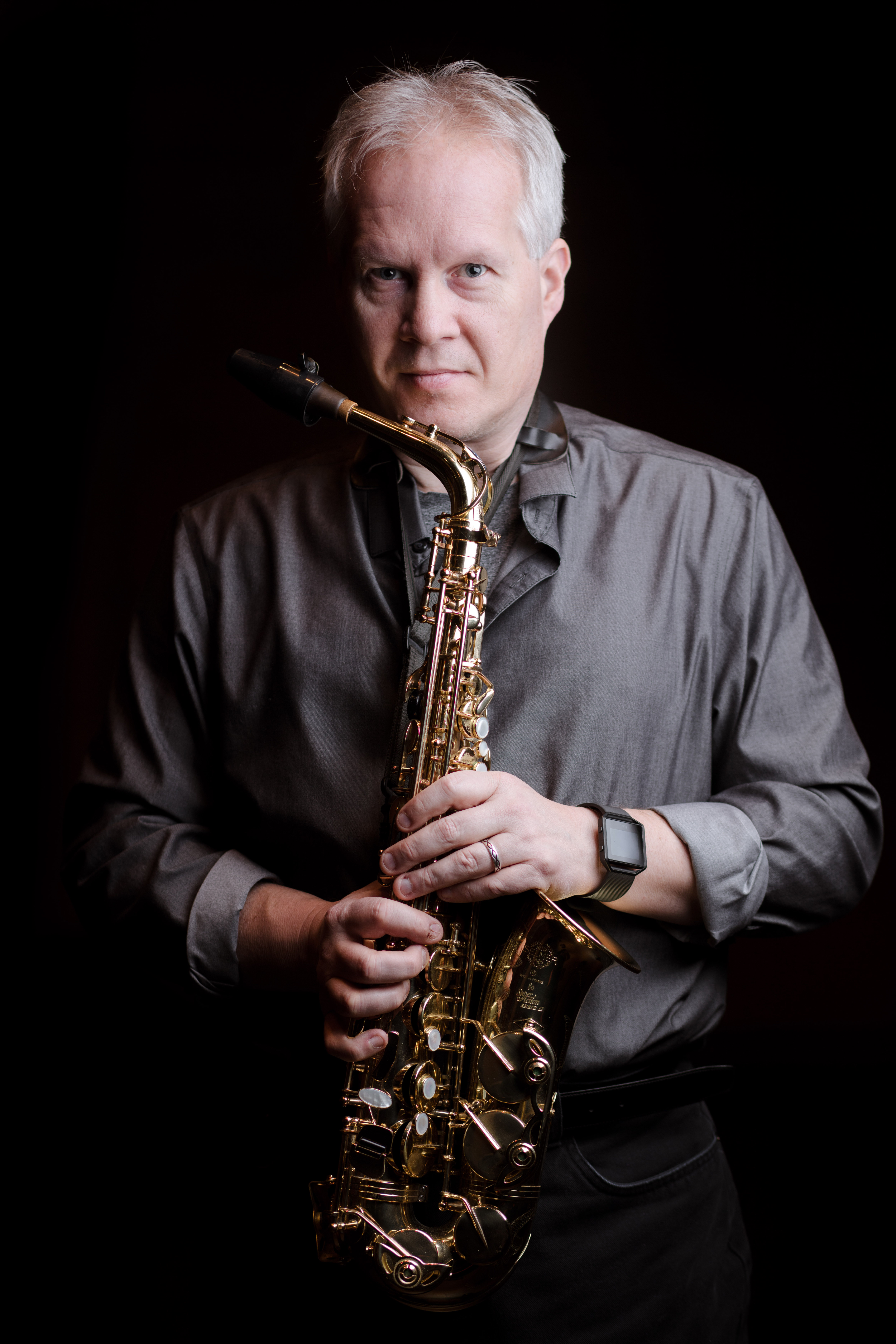 Kirk O’Riordan’s music has been referred to as “unapologetically beautiful” and is often praised for its uniquely “visual” qualities that depict a wide range of striking moods. His debut compact disk, Strange Flowers, was released by Ravello Records in November, 2013 and was praised by Audiophile Audition as “one of the most impressive and beautiful collections of chamber music I have heard in awhile….This is all just so lovely and invokes exactly the emotions that good music should be able to induce in all of us.” Gramophone Magazine praised O’Riordan as “a composer for whom imagery is a defining inspiration….[he] is a deeply sensitive composer who savours going gently into the night.” (April 2014).
Kirk O’Riordan’s music has been referred to as “unapologetically beautiful” and is often praised for its uniquely “visual” qualities that depict a wide range of striking moods. His debut compact disk, Strange Flowers, was released by Ravello Records in November, 2013 and was praised by Audiophile Audition as “one of the most impressive and beautiful collections of chamber music I have heard in awhile….This is all just so lovely and invokes exactly the emotions that good music should be able to induce in all of us.” Gramophone Magazine praised O’Riordan as “a composer for whom imagery is a defining inspiration….[he] is a deeply sensitive composer who savours going gently into the night.” (April 2014).
His recording of his Twenty-Six Preludes for Solo Piano—by pianist Holly Roadfeldt—has attracted similar praise: “are similarly atmospheric and proceed to unfold like a magical tapestry. Each of the 26 Preludes seemingly comprising of warp and weft forming a myriad of pixels of little pictures that ultimately combines to form a moveable feast for both eye and inner ear. O’Riordan’s miniatures are informed by languorous beauty and profundity, the lyrical variations of each often feature elaborate embellishments, as well as sudden dissonant figurations that seem to mimic the gravity-defying leaps of the gazelle…” (World Music Report, April 2017).
O’Riordan (b. 1968) is an active composer, conductor, saxophonist, and teacher. His music has been performed in Canada, China, Costa Rica, Cyprus, Finland, Italy, and Russia; and in thirty of the fifty United States. Performances of his works have been featured at the Ravenna Festival (Italy), the Indiana State University, University of North Carolina, Greensboro and Western Illinois New Music Festivals, the 2008 Eugene Rousseau Birthday Celebration, national and regional conferences of the Society of Composers, Inc. and the College Music Society; and in concert by such performers as the Eaken Piano Trio, Tresillo, The Moran Woodwind Quintet, Orchestra Bruno Maderna (Italy), the Arizona State University Chamber Winds and Symphony Orchestra, the Northwestern University Contemporary Music Ensemble, the Cleveland State University Orchestra, the University of Colorado Chamber Wind Ensemble, the University of Delaware University Singers, the Williamsport Chamber Chorus and Orchestra, the Susquehanna University Orchestra and Chamber Singers, The Lafayette College Concert Band, Contemporary Music Ensemble, and Percussion Ensemble, the SKIN Ensemble, Frederick Hemke, Timothy McAllister, Lawrence Stomberg, Marianne Gythfeldt, Kenneth Tse, Jeffrey Lyman, Emily Bullock, Steven Stusek, Andrew Rammon, Reuben Councill, John Perrine, and Holly Roadfeldt.
Kirk is te recipient of numerous awards as both a composer and a performer, including annual ASCAPlus awards, a Composer’s Assistance Program grant from the American Music Center, the 2001 Arizona State University Composition Competition, the 2000 Contemporary Music Society competition, and an ERM-Media Masterworks Prize. In addition, his Cadenza for Piano Trio was one of two works selected by audience members at the CMS Mid-Atlantic/Northeast Super-regional Conference for performance at the 2008 CMS National Conference.
Kirk’s music has been broadcast on WSMR, KBAQ, WQSU, and WVIA radio. Recordings of his works appear on the Crystal Records, Ravello, Centaur, ERM-Media and EnF labels, and feature performances by Kenneth Tse, Lawrence Stomberg, Marianne Gythfeldt, Holly Roadfeldt, Frederick L. Hemke, The Kiev Philharmonic, and Farrell Vernon. He has recently received commissions from AVIDduo, Saxton Rose, and Holly Roadfeldt. He recently completed his first opera: The Masque of Edgar Allan Poe, a one-act chamber opera based on Poe’s “Masque of the Red Death” on a libretto by Lafayette College colleague Lee Upton. The work was premiered by the University of Delaware Opera Theater in November, 2016 and subsequently at Lafayette College. Other projects have focused on music for dance: his River Lights for Orchestra (as recorded by the Kiev Philharmonic) was used by dancer/choreographer Ben Munisteri in his piece, Robot vs. Mermaid. O’Riordan has also collaborated with dancer/choreographers Carrie Rohman and Nandini Sikand. Recent projects include a concerto for Taiko Ensemble and Concert Band (for the Lafayette College Percussion Ensemble and Concert Band), incidental music for a Lafayette College Department of Theater production of Mary Zimmerman’s play Metamorphosis, and a new work for viola and piano for violist Michael Hall and pianist Holly Roadfeldt.
Dr. O’Riordan joined the faculty of Lafayette College in 2009, and now serves as Associate Professor of Music and Director of Bands, teaching courses in music theory, and composition. In addition, he teaches in the First-year Seminar program and conducts the Lafayette College Concert Band and Contemporary Music Ensemble. During his time at Lafayette, the Concert Band has been hailed for its ambitious and adventurous programming, having performed works such as Husa’s Music for Prague 1968, his own orchestration of Pictures at an Exhibition, and world premieres by O’Riordan, Ashley Kushner, Justin Kogasaka, Zach Jones, Pete Deshler, and William Pfaff. Previously, he served on the faculties of Bucknell University and Susquehanna University where he taught music theory, composition, music appreciation, and (English) writing. He has also served on the faculties of Lock Haven University, Colorado Christian University, Chandler-Gilbert Community College, and Paradise Valley Community College. He holds the Doctor of Musical Arts degree from Arizona State University (the first recipient of that degree from ASU); the Certificate of Performance in Saxophone from Northwestern University; and three Master of Music degrees (composition, saxophone performance, and conducting).
Kirk has studied composition with Rodney Rogers, Randall Shinn, James De Mars, Glenn Hackbarth, Jay Alan Yim, Burton Beerman, Marilyn Shrude, and Donald M. Wilson. He has studied saxophone with Frederick L. Hemke, John Sampen, Eugene Rousseau, and Iwan Roth. In his free time, Kirk is an avid fan of Obstacle Course Racing.
